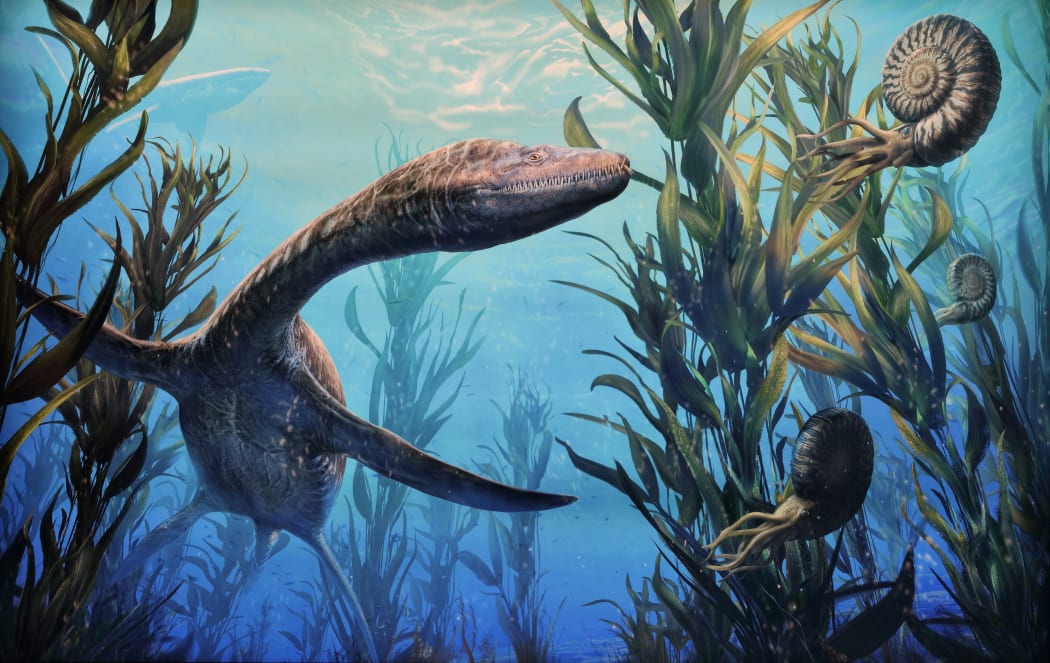Aotearoa has one of the world's richest troves of ancient marine fossils, but we're still just finding out exactly what it is we're sitting on. And some of the newest findings about plesiosaurs throw shade on so-called sightings of the Loch Ness monster, on the other side of the world.
Researchers have used medical CT imaging to scan some of New Zealand's oldest plesiosaur fossils, revealing a new level of detail.
Paul Scofield, senior natural history curator at Canterbury Museum and adjunct professor in geology at Canterbury University, told Emile Donovan about the findings.

Photo: AFP
Scofield said the scanned fossils, embedded in rock, were collected in Waipara in 1872 and housed in Canterbury Museum's storerooms for 120 years, unexamined.
"[Originally] they were recognised as being of an undescribed species of elasmosaur" - a type of long-necked plesiosaur."
In the 1990s some of the rock surrounding the fossils was able to be reduced, and local and visiting international scientists began to examine the fossils and publish their findings.
Then in 2019, Scofield took them to be scanned in a type of CT scanner newly bought by a local radiology clinic in Canterbury.
"[Before this] we couldn't see it through the matrix of rock that surrounded them, but using CT scanning we can actually look at this animal's inner ear, and we can determine that it's actually got features that we didn't know that elasmosaurs had.
"The orientation of the inner ear tells us that elasmosaurs forage and hold their head in quite a different way to what had previously been thought. They hold their head, and probably their neck as well, either horizontally or hanging down from the rest of the body.
This gives scientists more information about how the huge reptiles may have fed, Scofield said.
"[It] supports an idea that they were probably floating on the surface and their long necks were being used to basically dredge the sea floor for clams and pipi and other things."
The evidence throws doubts on some of the clues people have previously presented about the legend of the Loch Ness monster, Scofield suggests.
Nessie has been said by some to have been an elasmosaur, he explains. However, this new knowledge about the structure of the elasmosaur's ear, showing how it held its head down, contradicts so-called photos of sightings of Nessie with an upright neck.
Scofield said the fossils are also thought to be closely related to South American specimens from 70 million years ago.
Where do New Zealand's ancient marine reptiles fit, and where are our dinosaurs?
During the era these ancient marine reptiles lived New Zealand was on the edge of the super-content of Gondwana, west of the vast proto-Pacific ocean.
Māori have traditional whakataukī (sayings) telling of taniwha and other ancient creatures, and when European settlers arrived they began to find fossils of ancient sea creatures such as plesiosaurs and mosasaurs, some as big as a bus.
However the recorded evidence about ancient creatures that once lived where New Zealand now sits includes very little evidence about land-dwelling dinosaurs, compared to other parts of the world.
"Almost all of the rocks in New Zealand are of marine origin," Scofield said, compared to rocks formed on land or in fresh water, which are common in other parts of the world.
"That means that the animals that we find in [New Zealand's rocks] are generally ones from the sea. Our very few [true] dinosaurs are mostly animals that have washed down rivers and out into the sea."
The ancient sea reptiles in New Zealand's fossil records, like plesiosaurs and mosasaurs, may look like dinosaurs, but Scofield said they are technically more closely related to snakes and turtles than to dinosaurs, which are distant relatives to birds.
Much of New Zealand's rock formed after the ancient marine reptiles and the dinosaurs were wiped out. So fossilised evidence of animals from that far back can only found in places with the oldest rocks, which trapped remains such as bones within them as they formed.
"The number one places are in North Canterbury, and out on the... Chatham Islands, and also there's a really important site down inland from the Hawke's Bay," Scofield said.

